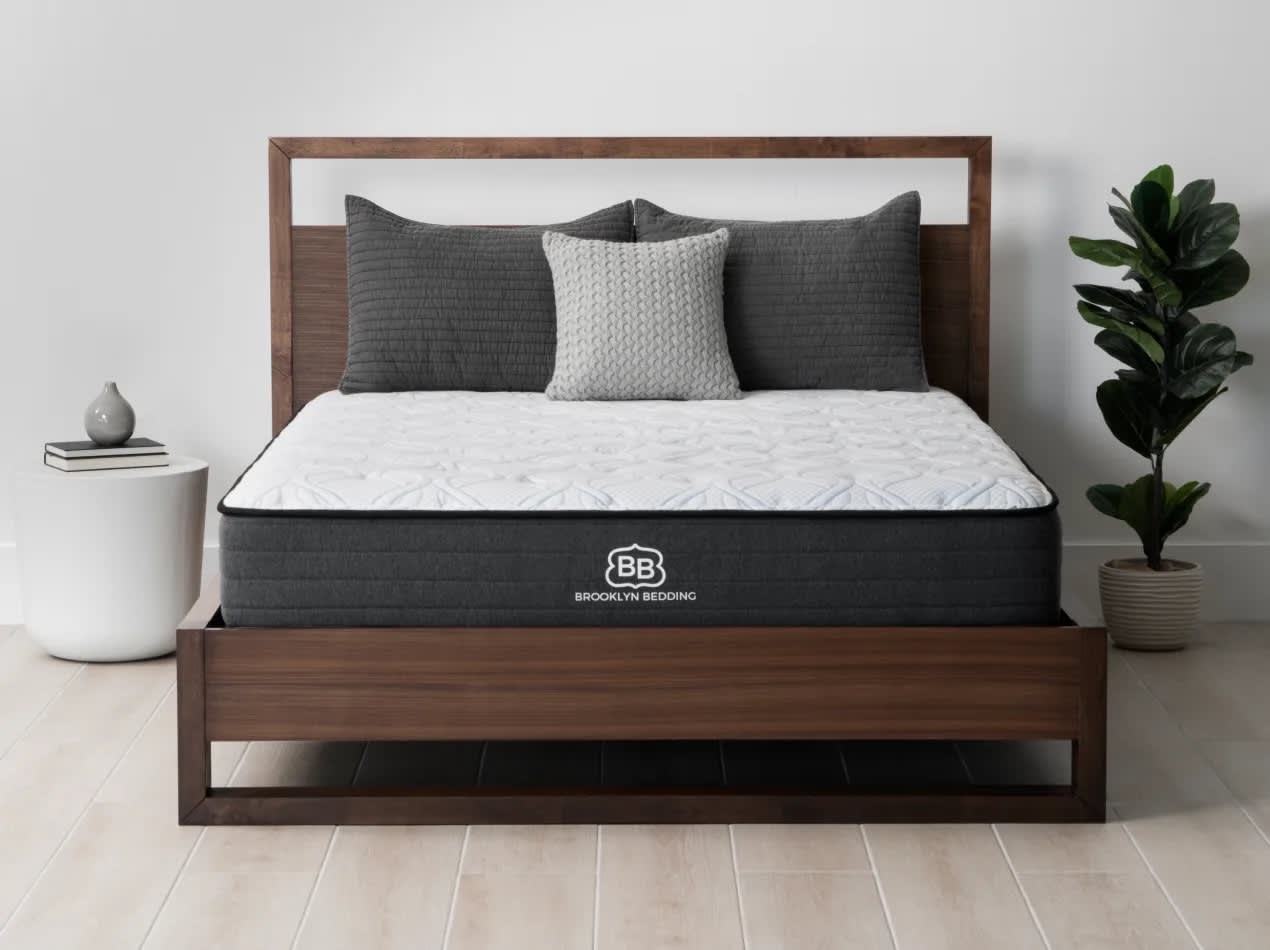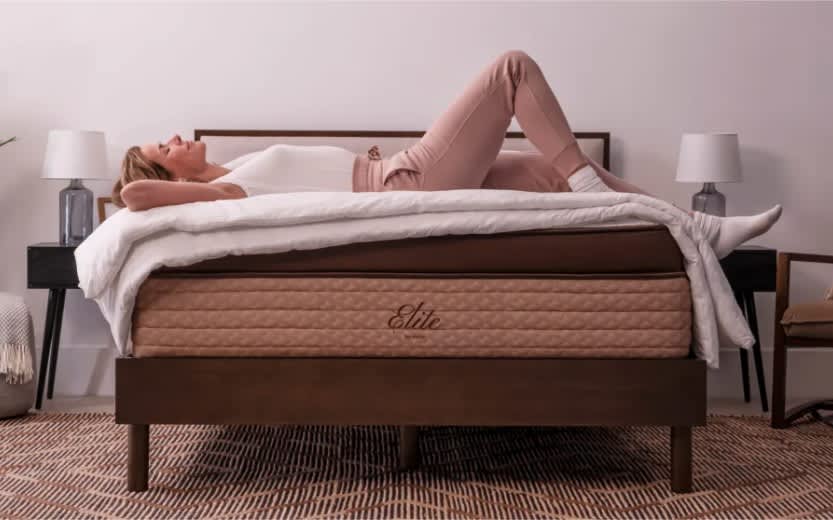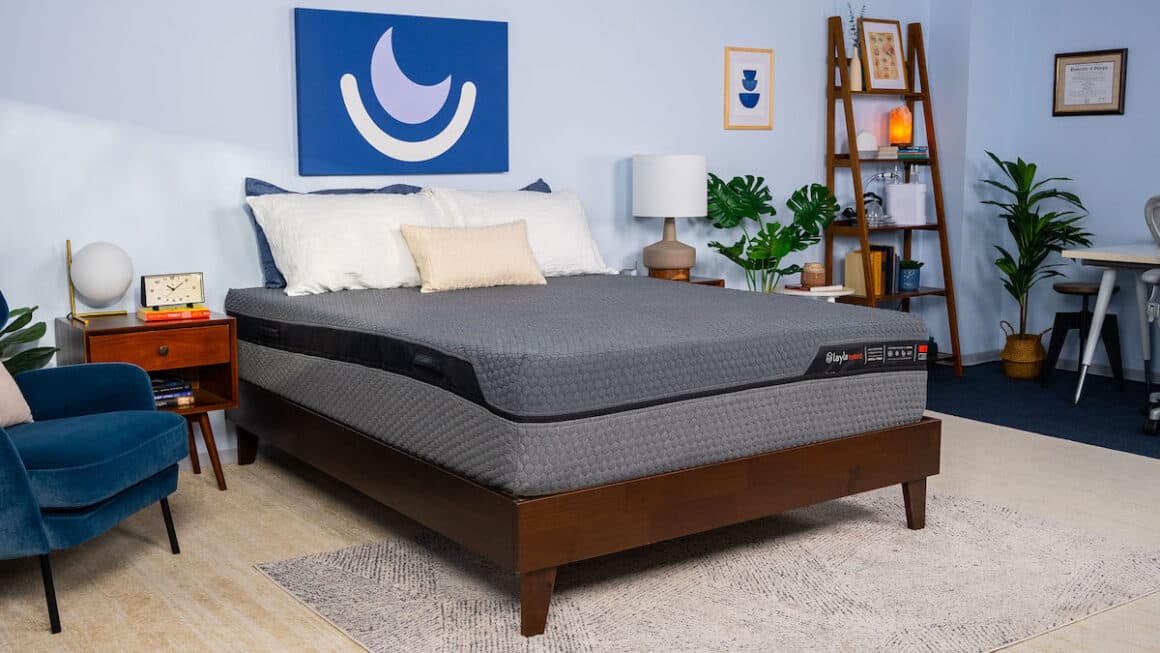On This Page
Best Mattresses Made in the USA
Top American-Made Picks
Our Top Picks
-
Best Overall Mattress
Saatva Classic -
Best Value Mattress
Brooklyn Bedding Essential -
Best Luxury Mattress
Helix Midnight Elite -
Best Mattress for Back Pain
WinkBed -
Best Mattress for Couples
Layla Hybrid
Best Overall Mattress

With a plush Euro-top and two layers of coils, the Saatva Classic provides a responsive, supportive surface without sacrificing pressure relief. Available in three firmness levels and two profiles, our testers had an easy time finding a model to suit their needs.
Pros & Cons
Pros
- Lumbar pad and zoned coils provide excellent spinal support
- Pocketed coil support core ensures robust edge support and strong temperature control
- Complimentary White Glove delivery and old mattress removal
Cons
- Coils allow motion to transfer across the mattress surface
- Luxury price-point
- Returns incur a $99 fee
Ratings
Our Take
Best Value Mattress

We appreciated the versatility of the Brooklyn Bedding Essential, which received solid comfort scores from testers with a wide range of body types and sleeping positions. It’s a competitively priced, no-frills hybrid mattress that delivers across key performance areas.
Pros & Cons
Pros
- Medium firm (6) surface is well suited to side, stomach, and back sleepers over 130 pounds
- Coil support core provides responsiveness for ease of movement
- High-density foams offered at a competitive price-point
Cons
- Hybrid design allows motion transfer when sleeping with a partner
- Sleeps warmer than other hybrid models
- May feel too firm to sleepers under 130 pounds
Ratings
Our Take
Best Luxury Mattress

Our testers reported that the Helix Midnight Elite lives up to its premium price-point. A high 16-inch profile houses layers of memory foam, microcoils, polyfoam, and zoned pocketed coils. The result is a balanced combination of pressure relief and support.
Pros & Cons
Pros
- Phase change fabric and multiple coil layers keep sleepers from overheating
- Isolates motion without limiting movement
- Zoned support system provides targeted support
Cons
- Lacks a strong enough structure for stomach sleepers over 230 pounds
- 16-inch profile requires deep pocket fitted sheets
- Ships in two boxes and requires a little more setup than usual
Ratings
Our Take
Best Mattress for Back Pain

The WinkBed offers zoned support designed to promote good posture. Available in four firmness levels, most types of sleepers should be able to find a WinkBed that accommodates them.
Pros & Cons
Pros
- Perimeter reinforcement provides strong edge support
- Available in four firmness levels that support a range of sleeper types and weight groups
- Zoned support system bolsters and cushions the lower back
Cons
- Firmest WinkBed has a higher price tag than the other models
- You may notice your partner’s movements from your side of the bed
Ratings
Our Take
Best Mattress for Couples

Our testers appreciated the Layla Hybrid’s balance of bounce and motion isolation. In addition to solid pressure relief, we found this model offers exceptional edge support so that sleep partners can use the entire surface area.
Pros & Cons
Pros
- Flippable design gives couples two surfaces to choose between
- Robust edge support on the firm side enables use of the entire mattress surface
- Soft side isolates motion to prevent disturbance to a sleeping partner
Cons
- Foam layers may restrict movement during sex
- Flipping the mattress may require a partner’s help
- Firm side lacks pressure relief, while soft side may retain heat
Ratings
Our Take
Compare Our Top Picks
| Mattress | Mattress Type | Ideal For | Value | Sleep Trial |
| Saatva Classic | Innerspring | Back Sleepers | Fair Value | 365 Nights ($99 Return Fee) |
| Brooklyn Bedding Essential | Hybrid | Budget Shoppers | Great Value | 120 nights (30-night requirement) |
| Helix Midnight Elite | Hybrid | Side Sleepers | Good Value | 120 nights (30-night requirement) |
| WinkBed | Innerspring | Side Sleepers | Good Value | 120 nights (30 night requirement) |
| Layla Hybrid | Hybrid | Side Sleepers Of Any Weight | Great Value | 120 nights |
If you’re in the U.S., there are a few reasons you may want to shop for an American-made mattress. For one, shopping local means that shipping is typically easier to coordinate and free or low-cost, saving you money and saving the mattress from having to ship internationally. Other shoppers like knowing that a mattress was produced according to U.S. standards for labor, health, and safety. Lastly, some consumers like shopping domestically to support the U.S. economy.
Benefits of Buying a Mattress Made in the USA
Purchasing a U.S.-made mattress has several distinct advantages, especially if you’re also based in the U.S.
Easy Shipping
Most American mattress manufacturers offer free shipping to addresses within the contiguous U.S. Shoppers in Alaska, Hawaii, and Canada may also qualify for free or low-cost shipping.
Fairer Labor Practices
Purchasing an American-made mattress ensures that workers were treated fairly under the terms of U.S. labor laws.
Health and Safety Standards
Mattress materials in the U.S. must meet Consumer Product Safety Commission standards indicating that they’re free from harmful chemicals or additives, whether in foam, textiles, latex, or other components.
Supports the Domestic Economy
Buying a mattress from a U.S.-based mattress company helps support the domestic economy and American workers.
Smaller Carbon Footprint
Mattresses are bulky to transport, and shipping overseas comes with a significant carbon footprint. While American-made mattresses may include some foreign components, it’s generally more environmentally friendly to buy local.
Less Storage Time
Manufacturers with a factory in the U.S. are often able to make mattresses to order, instead of shipping you a mattress that’s been sitting compressed in a warehouse for weeks or months on end.
How to Know You’re Buying a Mattress Made in the USA
The Federal Trade Commission (FTC) regulates made-in-America claims to protect consumers against misleading or false advertising. To use the term “American-made” or anything similar on packaging or advertising, a product’s materials must be “all or virtually all” made in a U.S. state or territory. Though these standards are strict, the FTC doesn’t require companies to submit their products for pre-approval, which leaves room for untrue claims.
Most mattress companies that tout American-made beds are transparent about where they source their materials. It’s not uncommon for a company to use certain materials sourced from overseas, but assemble the mattress in the U.S. If you’re unsure whether a mattress is fully made domestically, reach out to the company for clarification.
Certifications to Look For
Manufacturing and material standards exist on both U.S.- and foreign-made mattresses and their components. Common third-party certifications provide assurance that your new mattress meets strict environmental or health and safety standards.
| Certification | Description |
| CertiPUR-US | Foams with the CertiPUR-US label are certified free of certain harmful chemicals or additives including lead, formaldehyde, and ozone depleters. CertiPUR-US foams meet standards for low volatile organic compound (VOC) emissions. |
| OEKO-TEX Standard 100 | Textiles and accessories bearing the international OEKO-TEX Standard 100 certification have passed safety tests that check for over 1,000 harmful substances. |
| GREENGUARD Gold | The globally recognized GREENGUARD Gold certification signals that a particular product has low chemical and VOC emissions. |
How to Choose a Mattress Made in the USA
When shopping for any mattress, it’s important to consider your sleeping position, weight, and personal preferences. If you’re looking for the best mattress made in the U.S., you’ll also want to look at factors that set American-made models apart from the rest.
Durability
The average mattress lasts between six and eight years, though some models may reach up to 10 years before needing to be replaced. A model with high-quality materials can withstand repeated use better than those with lesser-quality components. American-made mattresses tend to have longer lifespans than budget models manufactured abroad, though there are exceptions.
Pricing
Mattresses made in the U.S. often cost more than low-quality models manufactured elsewhere. You can expect to pay between $700 and $2,000 for a mid-range, queen-size, American-made mattress. The average model costs about $1,200, while a luxury bed can reach over $3,000. Mattresses made outside the U.S. can cost as little as $200 for a queen, but the materials may not be as high-quality or durable.
The cost of a mattress is largely determined by the price of labor, materials, and warehouse spaces. These prices vary from country to country, with some countries offering a better deal and others facing higher costs.
Mattress Type
You can find American-made beds in all five of the common mattress styles: foam, latex, innerspring, hybrid, and airbed. Each mattress type has its own pros, cons, unique characteristics, and performance traits. For example, foam beds are known for pressure relief and motion isolation, while latex and hybrid beds tend to be more breathable and responsive. When choosing between them, consider what kind of feel you prefer and the qualities that are most important to you.
Video: Comparing the Major Mattress Types
Watch our video as our sleep experts break down the different types of mattresses you’ll find online and in stores across the country.
Discover More Mattress Solutions
Learn more about how the right mattress can change your sleep for the better and check out some of our other favorite mattresses and buying guides.
More Mattress Options for Specific Needs
How We Test
Our team of sleep product experts has been testing mattresses in our Seattle-based lab for almost a decade. In that time, we’ve tried hundreds of models that are made in the U.S. We put every mattress through the same series of rigorous trials to determine how well it performs on metrics like pressure relief, heat retention, and motion isolation. We also make sure that each mattress gets tried in person by testers representing different weight groups and sleeping position preferences.
Frequently Asked Questions
Mattresses made in the USA vary in cost, but the average mid-range queen model is around $1,200. The cost can range between $500 and $3,000 depending on construction type, material quality, design, and brand reputation. American-made beds often cost a bit more than those made outside the country because labor, materials, and factories can be expensive.
Mattresses made in the USA are not necessarily better than others, but buying a mattress made in the USA can give you peace of mind because it’s often easier to judge the quality.
Importing a mattress comes with a set of costs, so if you’re considering a cheap mattress from outside the U.S., be aware that there’s a chance that the manufacturer cut corners somewhere. On the flip side, some countries may produce excellent mattresses, but if they’re paying fair wages to their workers and complying with health and environmental standards, the end cost to a U.S. buyer may end up being prohibitive.
By buying local, you can get the best of both worlds: a mattress that meets American standards, without the need to pay exorbitant shipping and duty fees.
The average mattress made in the USA should last between six and eight years. Extremely durable models can stay supportive for up to 10 years, while low-end models may last less than six. These expected lifespans are in line with mattresses made overseas.
“Made in USA” labels are typically accurate, because the FTC sets standards that regulate the use of this phrase and other similar phrases. This label indicates that all or virtually all materials are made within a U.S. state or territory.
However, the FTC doesn’t require that products obtain pre-approval for using this label, so there are companies that take advantage and mark their products as American-made although they may not be. Reach out to a company’s customer service team if you’re unsure whether or not they’re actually a U.S.-based manufacturer.
